Morrow’s magical season
All-American champ parlays precise crankbait to stellar 2010
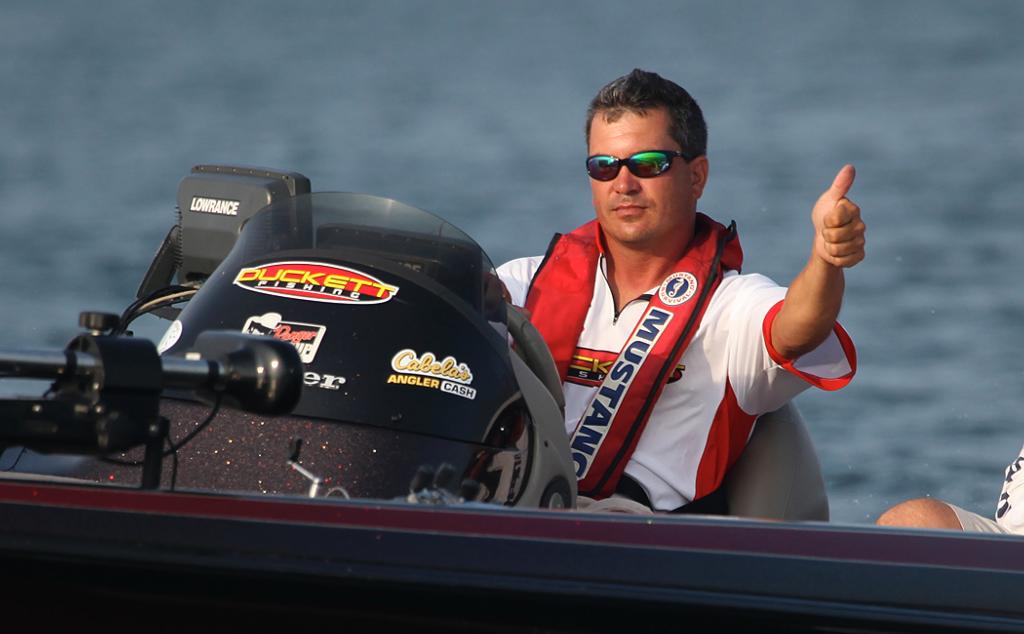
As the calendar year draws to a close, it’s time to reflect on some of the best performances of the season. Some bass-fishing fans will undoubtedly think about Bryan Thrift’s dominating Angler of the Year win and his long-awaited FLW Tour victory on Lake Norman. Others will likely point to Brent Ehrler, who won two of the five FLW Tour qualifiers and the FLW Series Western Division Angler of Year. But a weekend angler from Georgia also had a season for the ages. And despite racking up two wins and a fifth-place finish at the Forrest Wood Cup, he’s managed to slip under the radar.
That man is Troy Morrow, the winner of the 2010 BFL All-American on DeGray Lake. While the All-American was the first of his 2010 milestones, Morrow’s journey started much earlier and without a great deal of fanfare. In fact, it began with a simple two-fish tournament on Clarks Hill Lake, the 2009 season opener in the BFL’s Savannah Division.
“If you look back at what led to what, that was where it all started,” Morrow said. “I had a good year, a solid BFL season, but there was nothing spectacular that stood out. I had one top-10 during the regular season, and then I finished eighth in the two-day Super Tournament.
“In fact, I’ve never won a regular divisional BFL, and I’ve been fishing them since 1997.”
But that eighth-place finish in the Super Tournament gave him a berth in the 2010 All-American, the second All-American qualification of his career.
DeGray in transition
With the calendar reading late May, Morrow arrived in central Arkansas for his All-American practice figuring there would be a grass bite, something that didn’t exactly excite him.
“When I got there, it was void of grass; they must have killed it all,” he said. “But the water was pretty high, and it was obvious there was going to be fish up shallow in the bushes. And on that first day of practice, I caught about 20 pounds from the bushes. They were in it, and they were biting.”
While on his way to the next set of bushes, he spotted a promising brush pile on his graph that was 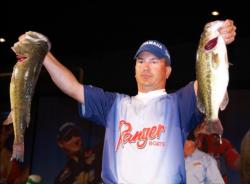 positioned in about 16 to 20 feet of water.
positioned in about 16 to 20 feet of water.
“I like to fish offshore; that’s what I do,” Morrow explained. “It’s truly one of my strong suits. After I found that pile, I basically rode around with my Lowrance until I had a bunch of piles. And it started to become clear that the bush bite was slowly dying. I also knew it was postspawn and that the water was falling. The bushes were at that point where if they lost any more water, they weren’t going to be the deal. That was enough to scare me away. The bushes were drying up, the water was heating up, and the bass were headed back down.”
Morrow’s best area was a U-shaped ridge located in the river channel at the beginning of the main-lake area. There was one particular hump in the center of the ridge that proved to be the consistent sweet spot.
“There were two islands in the area, a northern one and a southern one. At each end of the island there was a largemouth bite. And the center hump had a good spotted bass bite. The spot was just perfect. I could put my boat in 4 feet of water and throw out into 100 feet. And no matter which way it would blow, I would have wind. And there was current too; the fish would stack up and wait for a school of bait from the main-river channel.”
In the morning, Morrow would capitalize on a brief schooling window with a weightless Zoom Super Fluke. But then the fish would gradually migrate toward the brush. At that point he’d pick up a Spro Little John DD and crank away. At the time he didn’t realize it, but this proved to be a pivotal point in his entire season. His infatuation with the Little John had begun.
“I’d point at the pile, throw past it and try to clip it. The problem was, I only had a few of those crankbaits in clear chartreuse color. And I lost those two on back-to-back casts. On one I had a 7-pounder that broke me off in the pile. When I changed to chartreuse, I just caught pickerel after pickerel. By the end of the week, I had to scrape the paint off my brighter-colored cranks with a razor blade and some sand paper. Then my friend brought his air brush and repainted them. And that was after Scott Suggs borrowed me some. My biggest mistake was not bringing enough tackle.”
On the first day of the tournament, Morrow managed a solid 13-pound, 12-ounce limit. He moved into first place after day two with a 16-pound, 6-ounce sack. On the final day, he calmly caught 8-11 to secure the $120,000 win.
“Going into the final day, I knew I was in good position. Sitting there at the tanks, I was pretty sure I had it. And at that time, I was only thinking about that tournament. Then, afterwards, the emotions kind of overtook me, and I immediately started thinking about the Cup. I guess I even called out Tom Mann Jr. onstage, which could have been a big mistake. Luckily, it all worked out.”
Cup bound
Winning the All-American was huge, but the Forrest Wood Cup is the biggest stage in bass fishing. And in 2010, it was held on the deep, clear waters of Georgia’s Lake Lanier, which happens to be a stone’s throw away from Morrow’s residence in Toccoa, Ga.
“In 40 minutes I can have my boat in the water from my house,” Morrow quipped. “But the real benefit to winning the All-American was that I had a head start on practice. The Tour guys still had another 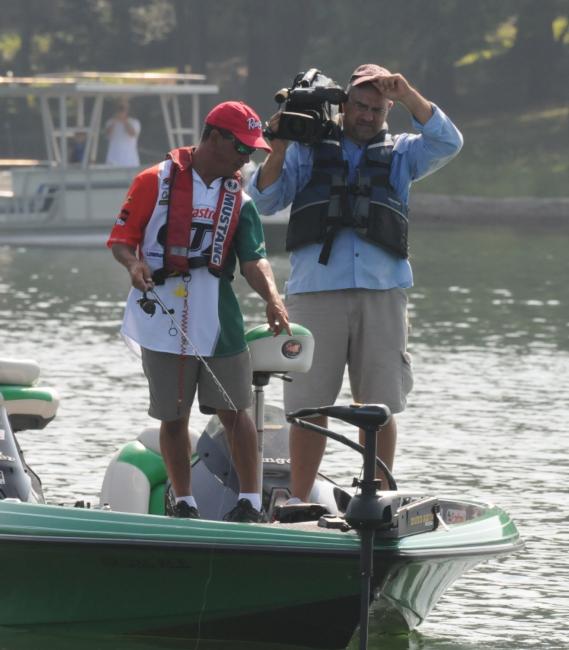 tournament left. And most of them hadn’t been on the lake or had put in very little time.”
tournament left. And most of them hadn’t been on the lake or had put in very little time.”
When his Cup practice began, Morrow had over 2,500 GPS waypoints stored from years of experience. The next step was tediously going through each one of them to determine its viability. To accomplish that, Morrow would first view the spot on his Lowrance graph and then take a closer look with his Marcum underwater camera. Many were eliminated, and his best 60 spots were flagged on his GPS under the color yellow.
“Needless to say, I did a lot of prepractice for the Cup. I stayed one time for a whole week straight – never left the campground. In total, I put in at least 40 days. I basically lived at Lanier for four months.”
Once the Cup commenced, Morrow steadily improved his daily weight and overall standing. He started with 10-14, then climbed to 11-8 and finished the opening round in sixth place with 12-11 and a total weight of 35 pounds, 1 ounce. On the final day, Morrow said he stuck with the drop-shot too long and caught only three keepers that weighed 6 pounds, 12 ounces. The 38-year-old finished the Cup fifth and earned $50,000.
“That was my goal coming in: to make the cut. I had the fish to do better too. I didn’t have to manage anything, but the quality of the bite went way down. Towards the end of practice, I was averaging almost 15 pounds a day.”
Morrow’s baits for the Cup were not surprising – a standard drop-shot/finesse-worm combo and the same Spro Little John DD crankbait. In addition, Morrow would spend about a half-hour each day throwing a Brian’s Bees Prop Bee (No. 2) in the backs of creeks for a kicker largemouth.
“I probably caught the same number of fish on the drop-shot as I did the crankbait, but the ones that came on the plug were definitely bigger. If I had to do it all over again, I would have started with the crankbait and never put it down. On the final day, all three of my keepers came on the Spro.”
New tricks on classic tournament venue
After another relatively nondescript BFL regular season, Morrow finished 2010 with a bang at the three-day Lake Seminole Regional Championship. Known primarily for flipping, Seminole, which straddles the Georgia-Florida border, can be one tough cookie in the fall.
“I used to hate going to Seminole; the bite is always slow, and the fish always seem to be needles in a haystack. In the past I’ve even gone way up the Flint River in a glass boat just to avoid it.”
For no other reason than conventional wisdom told him to, Morrow started his BFL Regional practice by flipping and throwing frogs. After two fruitless days, he had had enough of the grass and again decided to head offshore – this time by targeting ledges.
After two days of searching, Morrow found two defined river ledges on the lower end of the Flint.
“The ledge was as deep as 20 feet, and the top was as shallow as 11 feet. I’d take that same Spro Little 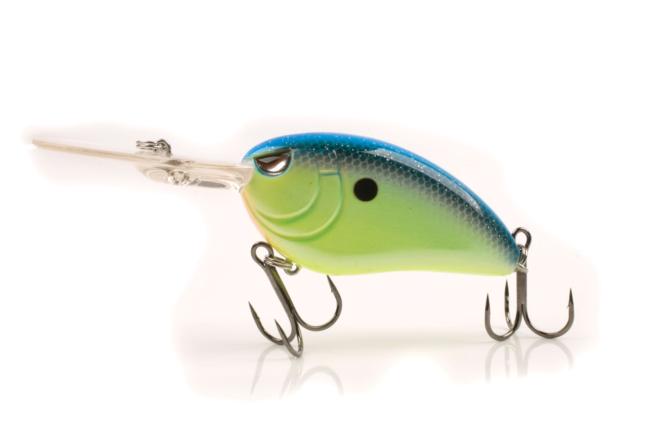 John and bounce it off the rock. As soon as that crankbait deflected, I’d get bit. On day one, I caught two just like that on consecutive casts. On the second day, I reversed the rotation of my spots. It was slower at first, but then I got back to my best spot and again caught two big ones on back-to-back casts. A little bit later I caught two more giants and filled out a 20-pound limit.”
John and bounce it off the rock. As soon as that crankbait deflected, I’d get bit. On day one, I caught two just like that on consecutive casts. On the second day, I reversed the rotation of my spots. It was slower at first, but then I got back to my best spot and again caught two big ones on back-to-back casts. A little bit later I caught two more giants and filled out a 20-pound limit.”
Morrow finished the event with a three-day total of 44 pounds, 2 ounces. He won the tournament by 5 pounds and earned a Chevy truck and Ranger boat along with yet another berth to the All-American.
“That style of fishing is not normal on Seminole. I think it took a lot of people by surprise, locals included.”
Spro factor
Morrow credits much of his 2010 success to the Spro Little John DD. In fact, at the Seminole Regional he didn’t weigh a single fish on another lure. He says part of the reason it’s so effective is because it’s so different than the other deep-divers on the market.
“All of the other baits are so similar. The Spro has a different shape with completely flat sides. And the thing will dive 20 feet every time on every cast. And it has a unique, quieter sound. It’s almost like they coat the tungsten ball in rubber. Instead of a rattle, it sounds more like a thud.
“If you think about it, that bait produced in the postspawn (DeGray), summer (Lanier) and fall (Seminole).”
Future plans
Of the three 2010 milestones, Morrow points to the All-American as the most satisfying.
“I think you take something different from each one. But the All-American was probably the biggest. The 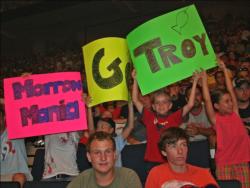 Cup gave me a little taste, and now I want to come back.”
Cup gave me a little taste, and now I want to come back.”
And come back he will. In addition to the All-American, Morrow plans to fish all 10 FLW Tour events in 2011. His first tournament is just around the corner at Lake Okeechobee in February, but he’s particularly excited for stop No. 3 on Lake Hartwell. Even more so than Lanier, Morrow considers Hartwell home water. In other words, Fantasy Fishing players take note.
“Nobody on Tour fishes Hartwell. They don’t have a clue. I’m expecting a big finish at that one. If I don’t do well, it will be a major disappointment.”
And although he’ll be a rookie pro, Morrow has the confidence to compete against the best.
“Other than that crankbait, homework and confidence have been the keys to my success. I wouldn’t be out there if I didn’t think I could compete.”
He also credits the unwavering support of his family.
“I have a wife and two girls at home. My wife, Sarah, is very supportive; she’s the reason I get to do this.”
Notable: Morrow’s BFL All-American win airs Jan. 9. The show can also be viewed on demand in its entirety by clicking here.